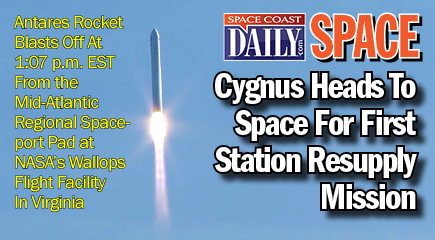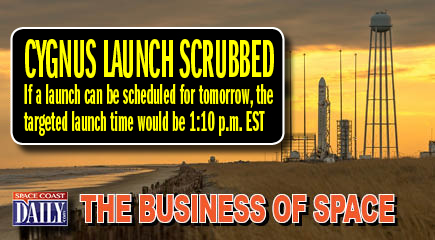Cygnus Heads To Space For First Station Resupply Mission
By NASA.gov // January 9, 2014
Cygnus spacecraft will arrive at ISS early Sunday
ABOVE LIVE STREAM: Orbital Sciences Corporation launched its Cygnus cargo spacecraft aboard the Antares rocket at 1:07 p.m. EST Thursday from the Mid-Atlantic Regional Spaceport Pad.
NASA.gov – NASA commercial partner Orbital Sciences Corporation launched its Cygnus cargo spacecraft aboard the Antares rocket at 1:07 p.m. EST Thursday from the Mid-Atlantic Regional Spaceport Pad 0A at NASA’s Wallops Flight Facility in Virginia for the Orbital-1 cargo resupply mission to the International Space Station.
› Complete Coverage of Cygnus

At the time of launch the station was flying about 260 miles over the Atlantic Ocean just off the coast of Brazil.
Over the next two and a half days, Cygnus will perform a series of engine firings to put it on track for a Sunday morning rendezvous with the station.
When the vehicle reaches the capture point about 30 feet from the complex, Expedition 38 Flight Engineers Mike Hopkins and Koichi Wakata will use Canadarm2, the station’s 57-foot robotic arm, to reach out and grapple Cygnus at 6:02 a.m. The crew then will use the robotic arm to guide Cygnus to its berthing port on the Earth-facing side of the Harmony node for installation beginning around 6:20 a.m.
Live stream coverage of the rendezvous and berthing begins at 5 a.m. Sunday, followed at 7 a.m. with coverage of the installation.

(NASA/Bill Ingalls image)
For its first official commercial resupply mission, designated Orbital-1, Cygnus is delivering 2,780 pounds of supplies to the space station, including vital science experiments for the Expedition 38 crew members aboard the orbiting laboratory. Orbital Sciences successfully proved the capability of the Cygnus spacecraft during its first and only demonstration flight to the station back in September 2013.
› Learn More About the Science Aboard Cygnus
Cygnus will remain at the station until mid-February when it will be unberthed from the station for a destructive re-entry over the Pacific Ocean. That departure will clear the way for the arrival of Space Exploration Technologies’ SpaceX-3 commercial cargo mission aboard the Dragon spacecraft. These two back-to-back resupply missions by U.S. companies will mark a milestone in NASA’s ability to deliver critical new science payloads to the only laboratory in space.
UPDATE: January 8, 2014 – 6:21 PM EST
Orbital Sciences Launch Set Tomorrow At 1:07 p.m.
SEE THE LIVE STREAM BEGINNING AT 12:45 p.m.
NASA.gov – Orbital Sciences has confirmed it will proceed with a 1:07 p.m. EST launch attempt of the Orbital-1 cargo resupply mission to the International Space Station (ISS) on Thursday, Jan. 9, pending closeout of all remaining pre-launch reviews and tests.
Orbital conducted a comprehensive review of data related to the radiation environment in space, further reviews and modeling of the rocket’s avionics systems, and the forecast for favorable terrestrial weather conditions at NASA’s Wallops Flight Facility in Wallops Island, Va.

Upon a deeper examination of the current space weather environment, Orbital’s engineering team, in consultation with NASA, has determined that the risk to launch success is within acceptable limits established at the outset of the Antares program.
NASA Television coverage of launch will begin at 12:45 p.m. EST. A post-launch news conference would follow at approximately 2:30 p.m.
A Thursday launch would result in the Cygnus spacecraft arriving at the ISS on early Sunday, Jan. 12. NASA TV coverage of rendezvous and berthing will begin at 5 a.m. EST for a 6:02 a.m. capture.
Coverage of installation of Cygnus will begin at 7:00 a.m. EST.
For the latest information on briefing and coverage times, follow NASA.gov/Station and the NASA TV schedule at NASA.gov/ntvnews.
UPDATE: January 8, 2014 – 9:14 AM EST
NASA.gov – Early this morning, Orbital Sciences Corp. decided to scrub today’s launch attempt of the Antares rocket and the Cygnus cargo spacecraft on the company’s first resupply mission to the International Space Station due to an unusually high level of space radiation that exceeded constraints imposed on Antares.

The solar flux activity that occurred late yesterday afternoon resulted in an increasing level of radiation beyond what the Antares engineering team monitored earlier in the day.
Overnight, Orbital’s engineers conducted an analysis of the radiation levels, but the Antares team decided to postpone the launch to further examine the potential effects of the space radiation on the rocket¹s avionics. The Cygnus spacecraft would not be affected by the solar event.
Today, in consultation with NASA, Orbital Sciences will continue to monitor the levels of space radiation with a goal of setting a new launch date as soon as possible.
If a launch can be scheduled for tomorrow, the targeted launch time would be 1:10 p.m. EST, with Cygnus arriving at the ISS Sunday morning, Jan. 12, for a grapple at 6:02 a.m. EST. If a launch can be conducted Thursday, NASA TV coverage would begin at 12:45 p.m. EST.
At Mission Control in Houston, the flight control team reported that the ISS crew is not affected by this solar event and does not require any special precautionary measures.
POSTED: January 6, 2014
Wallops Flight Facility, Virginia — At a Launch Readiness Review Monday, managers for Orbital Sciences Corp. of Dulles, Va., and NASA gave a “go” to proceed toward the Wednesday, Jan. 8, launch of the Orbital-1 cargo resupply mission to the International Space Station, pending the completion of remaining testing, data reviews and a Wallops Range Authority to Proceed.

Orbital is targeting a 1:32 p.m. EST launch from Mid-Atlantic Regional Spaceport Pad-0A at NASA’s Wallops Flight Facility in eastern Virginia. NASA Television coverage of the launch will begin at 1:00 p.m.
There is a 95 percent chance of favorable weather at the time of launch. High, thick clouds are the primary concern for a weather violation. If needed, multiple back-up launch opportunities are available through Jan. 12.
WEATHER FORECAST 95 PERCENT FAVORABLE
Orbital is targeting a 1:32 p.m. EST launch from Mid-Atlantic Regional Spaceport Pad-0A at NASA’s Wallops Flight Facility in eastern Virginia.
NASA TV will broadcast two news briefings today at the Wallops Visitors Center. A preview of the mission’s science cargo will air at 2 p.m. and a prelaunch status will air at 3 p.m. The briefings will be carried live on NASA TV and the agency’s website at NASA.gov/ntv.
NASA will take questions from Twitter and Google+ in advance of and during the briefing using the hashtag #AskNASA. To learn more about all the ways to connect and collaborate with NASA, visit: NASA.gov/connect.












